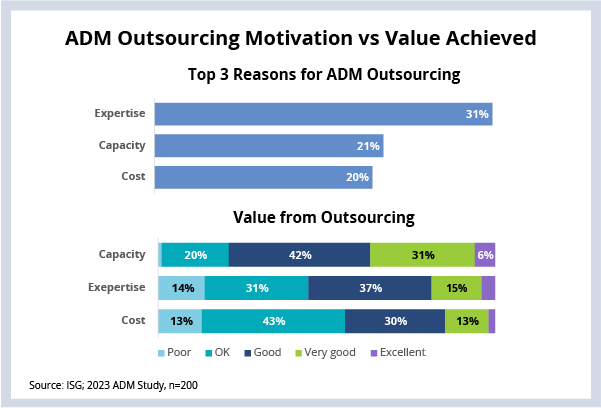If someone forwarded you this briefing, consider subscribing here.
ADM BUYER PRIORITIES
Earlier this week, ISG released our 2023 Buyer Behavior Study on application, development and maintenance (ADM). The study looked at ADM budgets, priorities, challenges, lifecycles and outsourcing trends. Given our focus last week on the trends in IT service provider hiring, we want to take a look at how these hiring trends dovetail with enterprises’ outsourcing objectives.
When we looked at the primary reasons enterprises outsource ADM, we found that their top three motivations are expertise, capacity and cost.
However, when we asked enterprises to rate the value they were getting from their ADM providers, enterprises rated capacity most highly and expertise and cost worst. Around half of respondents said those attributes were performing poorly (see Data Watch).
DATA WATCH

The Outsourcing Triangle
Some of you may be familiar with a concept called the engineering project triangle – a triangle with three points : good, fast and cheap. The maxim goes that you can only pick two as project constraints, and you must exclude the third. For example, you can build a project that is fast and good, but it won’t be cheap. Or you can build a project that is cheap and fast, but it won’t be good. The idea of choosing between constraints can be applied to outsourcing objectives, too.
Enterprises can prioritize two out of three – capacity, expertise or cost – but can only reasonably expect high performance in two of them. Unfortunately, regardless of what they prioritize, most enterprises feel confident achieving only one out of the three outcomes – capacity.
Given that context, last week’s update on hiring – which indicates that only 14% of the IT services workforce joined their firm in the last year – leads to two possible conclusions. One, that hiring has slowed and that service providers are doubling down on developing their expertise, or two, that having struggled to deliver expertise and cost savings, providers have slowed hiring and that this may jeopardize capacity in the future.
Of course, the wildcard that bears mentioning is that AI has the potential to disrupt all three points on the outsourcing triangle. As a pair programmer, AI has already been shown to increase productivity and improve performance (providing expertise), to automate increasingly complex workflows (providing capacity), and, in the long run, if it succeeds at both of these, it will ultimately reduce costs.
For the foreseeable future, the problem of enterprise AI adoption may be largely circular. Organizations will want to leverage AI to augment the skills they have in order to help build AI into their applications, which in turn helps augment the skills of the workers using those applications. For enterprise clients, structuring the ADM outsourcing contracts and relationships with providers to focus on expertise as one of the two points of the triangle (capacity or cost being the other) will help them break out of the current loop.
